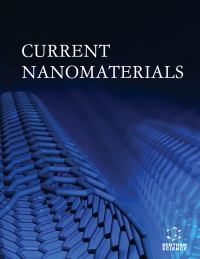- Home
- A-Z Publications
- Current Nanomaterials
- Previous Issues
- Volume 8, Issue 1, 2023
Current Nanomaterials - Volume 8, Issue 1, 2023
Volume 8, Issue 1, 2023
-
-
Curcumin-based Nanoformulations to Target Breast Cancer: Current Trends and Challenges
More LessAuthors: Adnan Badran, Joelle Mesmar, Nadine Wehbe, Riham E. Kurdi, Digambara Patra and Elias BaydounBreast cancer remains one of the most common cancers in women worldwide, and despite significant improvements in treatment modalities, the prognosis of this cancer is still poor. Herbs and plant extracts have been associated with various health benefits, and traditional folk medicine is still receiving great interest among patients as proven by accumulated records, tolerable side effects of herbal compounds compared to the Read More
-
-
-
Nanostructured Lipid Carriers: A Promising Carrier in Targeted Drug Delivery System
More LessNanostructured Lipid Carriers (NLCs) are considered second-generation lipid-based pharmaceutical formulations in drug delivery systems. It is a more efficient drug delivery system that includes the development of a nano-particulate system, and it is superior to the conventional drug delivery system. Among all available nanoparticles, NLC has gained more attention due to its superior characteristics, such as being lipophilic, bi Read More
-
-
-
A Review on the Use of Nanomaterials in Agriculture: Benefits and Associated Health Risks
More LessAuthors: Punit Kumar, Sujata Malik and Kashyap K. DubeyBackground: The present world population is about 7.9 billion and it is increasing continuously. Thus, there is an urgent requirement to enhance the agricultural output sustainably. Agricultural approaches such as the use of advanced agriculture methods, high productivity varieties, and enhanced application of fertilizers and pesticides have significantly increased food grain production but in an unsustainable way. Chemical-based c Read More
-
-
-
Green Synthesis of Copper Oxide Nanoparticles Using Eichhornia Crassipes Leaf Extract, its Antibacterial and Photocatalytic Activities
More LessAuthors: Tamene S. Saligedo, Gutta G. Muleta, Tilahun W. Tsega and Kirubel T. TadeleBackground: Green approach is among the preferable methods for metal-based nanoparticles synthesis due to its simplicity, cost-effectiveness, eco-friendly reagents, and a broad spectrum of biological activities. This study aimed to synthesize copper oxide nanoparticles using Eichhornia Crassipes (Water hyacinth) leaf extract in an eco-friendly manner. Methods: Copper oxide nanoparticles were synthesized using Eichhor Read More
-
-
-
Octahedron-Shaped Nano FeCo2O4 Phase Materials: Wet Chemical Synthesis and Characterization Studies
More LessBackground: Amongst the different spinel cobaltites investigated to date, the FeCo2O4 phase has been relatively less studied in detail despite the potential applications in several areas. As the nanostructured spinels are sensitive to the processing conditions, we have extended our research interest in FeCo2O4 phase materials. Objective: The objective of this study is (i) to synthesize the FeCo2O4 nanomaterials by different ap Read More
-
-
-
Nanosilver-Reinforced AgSn Alloys for Dental Applications: Mechanical Behavior and Hardness
More LessAim: AgSn alloys of different compositions were prepared by direct mixing with silver nanoparticles, and synthesized, in turn, by an environmentally friendly method. Methods: The procedure was carried out by following the standard technique for preparing dental materials and devices. A detailed mechanical characterization, including the maximum elongation at break, the ultimate tensile strength and the hardness of the Read More
-
-
-
Cytotoxic Effect of Podophyllotoxin-Loaded Magnetic Nanoparticles on Proliferation of Colorectal (HT-29) and Breast (MCF-7) Cancer Cell Lines
More LessBackground: Treatment used for cancer is generally associated with serious side effects. New solutions for cancer therapy can overcome the shortcomings and problems of conventional therapies by designing drug delivery nanosystems. Methods: In this study, magnetic Fe3O4@AU@albumin core-shell-shell (CSS) nanoparticles were synthesized and characterized by various analyses, such as transmission Read More
-
-
-
Cinacalcet HCl-Loaded PLGA Nanoparticles Using the Porous Carrier
More LessBackground: Cinacalcet HCl is a calcimimetic, BCS class IV drug with low oral bioavailability. Polymeric nanoparticles are widely used as biomaterials owing to their biocompatibility, biodegradability, varied structures, low toxicity, and simple and easy formulation process. Objective: The aim of the study was to enhance the oral bioavailability of poorly water-soluble drug, i.e., cinacalcet HCl, by using a suitable particulate nanocarrier Read More
-
Most Read This Month
Article
content/journals/cnm
Journal
10
5
false
en


